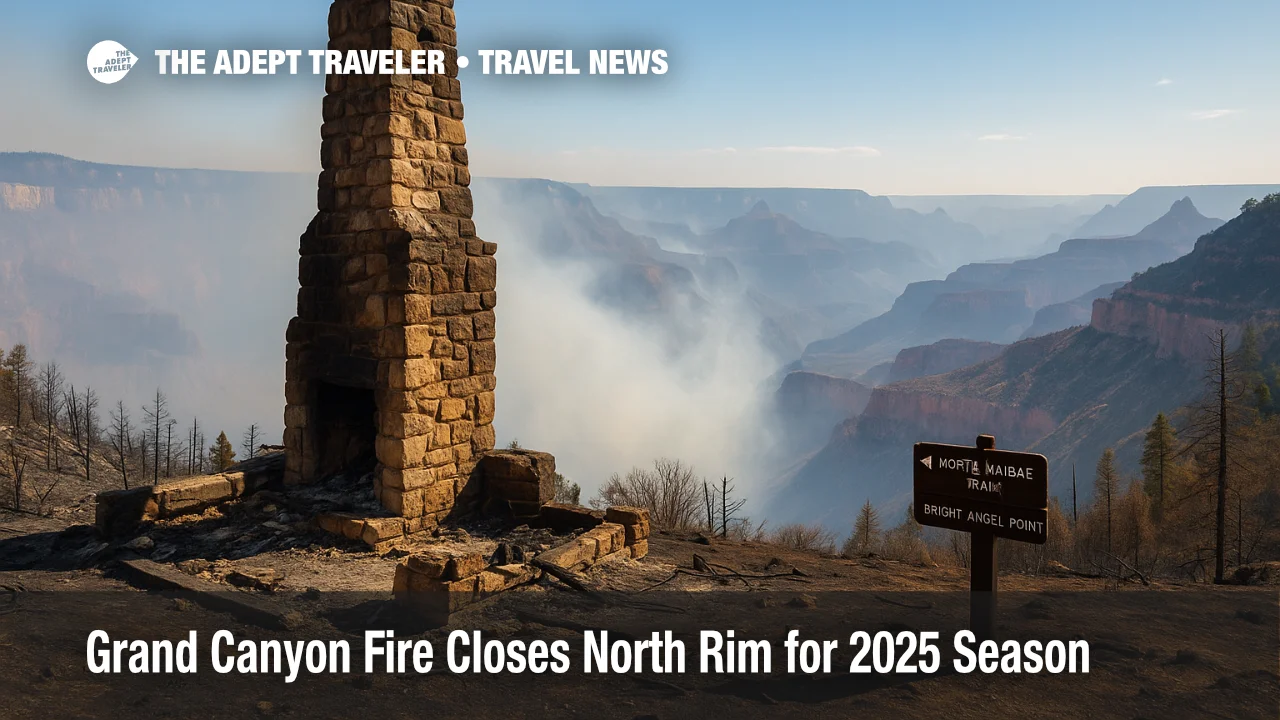Grand Canyon Fire Closes North Rim for 2025 Season

The Dragon Bravo Fire has forced Grand Canyon National Park to shutter its entire North Rim for the rest of 2025, destroyed dozens of historic buildings-including the Grand Canyon Lodge-and continues to challenge more than 1,000 firefighters. Ignited by lightning on July 4 and now covering roughly 28,800 acres with 26 percent containment, the fast-moving blaze is pushing smoke into the inner canyon and prompting widespread trail and campground closures. Travelers heading to Arizona must plan around the ongoing Grand Canyon fire and related restrictions.
Key Points
- Why it matters: The fire has erased 70 structures and closed the North Rim during the peak travel season.
- Dragon Bravo Fire spans about 28,800 acres; containment holds at 26 percent.
- U.S. Route 89A has reopened, but State Route 67 to the park remains shut.
- Iconic inner-canyon trails-South Kaibab, North Kaibab, and lower Bright Angel-are off-limits.
- South Rim services are open, though air-quality alerts persist.
- Recovery planning for 2026 is under way but could take years.
Snapshot
Fire-weather red-flag days and single-digit humidity have kept the Dragon Bravo Fire active across mixed conifer and ponderosa pine on the Kaibab Plateau. Winds gusting to 20 mph pushed flames toward visitor facilities on July 12, wiping out the stone-and-timber Grand Canyon Lodge and adjacent cabins. Crews now focus on holding control lines along Forest Roads 610, 611, and 223 while aviation assets scoop from Lake Powell. Smoke is visible from both rims, and a Temporary Flight Restriction has been expanded-though helicopter sightseeing routes remain mostly unaffected. Officials estimate more than 500 evacuees were sheltered on the South Rim after early-July closures.
Background
Lightning sparked the Dragon Bravo Fire on July 4 during an early-monsoon thunderstorm. Initial "confine and contain" tactics shifted to full suppression once extreme heat, low humidity, and downslope winds accelerated fire growth. By July 11 the blaze had forced evacuation of 400 park workers, concession staff, and 54 trail mules. The next night flames overtook the 96-year-old Grand Canyon Lodge, the North Rim Visitor Center, and multiple guest cabins-about 70 structures in all. Park managers closed every North Rim facility for the season, citing unsafe infrastructure, damaged utilities, and lingering hotspots. A Burned Area Emergency Response team is now assessing stabilization needs.
Latest Developments
Containment Progress Edges Up
Incident Management Team 4 reports 26 percent containment-up from 18 percent earlier in the week-after crews deepened firelines and installed sprinklers around the Kaibab Lodge and gas station. Aerial tankers checked run-outs along Dragon Creek, while ground crews masticated hazard trees near the park entrance. Forecast dry lightning and 8 percent afternoon humidity could reverse gains, so contingency lines are being scouted northeast of Lookout Tower Road.
Highway 89A Reopens, Trails Stay Shut
Coconino County and ADOT reopened U.S. Route 89A under pilot-car escort, restoring access to Jacob Lake Inn and Kaibab Camper Village. State Route 67-and thus any public approach to the North Rim-remains closed. Inside the canyon, the North Kaibab and South Kaibab Trails, Phantom Ranch, Bright Angel Campground, and sections of the River Trail and Tonto East stay off-limits. Only Bright Angel Trail up to Havasupai Gardens is open, limiting corridor hikes.
South Rim Open but Smoky
The South Rim continues to welcome visitors, though shifting winds periodically degrade visibility and push AQI into the moderate-unhealthy range. Park rangers advise limiting strenuous hiking during smoky periods and checking air-quality dashboards before setting out. Lodging, shuttles, and restaurants operate normally, but ranger programs now include daily wildfire briefings.
Analysis
The loss of the North Rim-home to just 10 percent of the canyon's annual 4.7 million visitors but a disproportionately high share of overnight stays-will ripple through northern Arizona's tourism economy. Jacob Lake, Page, and Kanab typically rely on overflow demand from rim-to-rim hikers and international tour groups seeking cooler summer temperatures. With the corridor trails severed, outfitters face cancellations for guided rim-to-rim treks and mule trips; river-running exchanges may need rerouting, adding cost and complexity. On the South Rim, hotels could experience compressed demand, especially if smoke-driven visibility issues spike refund requests. Air tours may also adjust flight paths to avoid the expanded TFR, potentially shortening scenic loops or increasing fuel burn. Long term, rebuilding the Grand Canyon Lodge poses cultural and architectural challenges: preserving rustic National Park Service style while integrating fire-resilient materials. Funding will likely blend congressional appropriations with philanthropic support through Grand Canyon Conservancy, but planners caution that reconstruction could stretch into the next decade.
Final Thoughts
Travelers eyeing late-summer or fall Grand Canyon trips should pivot to the South Rim and build flexibility into itineraries, monitoring daily smoke updates and any trail reopenings. Expect crowding at viewpoints usually spread between rims, and reserve lodging well ahead. The North Rim's closure underscores how drought and extreme weather keep reshaping iconic U.S. parks-reminding visitors to check conditions, buy insurance, and practice Leave No Trace. Stay vigilant as crews continue battling the stubborn Grand Canyon fire.
